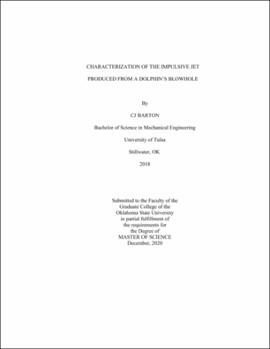| dc.contributor.advisor | Gaeta, R. J. | |
| dc.contributor.author | Barton, C. J. | |
| dc.date.accessioned | 2021-05-25T20:42:26Z | |
| dc.date.available | 2021-05-25T20:42:26Z | |
| dc.date.issued | 2020-12 | |
| dc.identifier.uri | https://hdl.handle.net/11244/329974 | |
| dc.description.abstract | The health of bottlenose dolphins can be monitored by marine biologists through the analysis of their exhaled breath. Unique concepts to capture this breath in the wild include flying an Unmanned Aerial System (UAS) through this exhaled breath to capture the key hormone cortisol. The breath is multiphase by nature, consisting of unknown quantities of particles (e.g., mucus, water) and air. In order to help design such a UAS, a multi-phase jet is designed to simulate a dolphin's breath through its blowhole, which has been established in the literature to be 20-140 liters/s in 0.26-0.31 seconds. A 3D printed replication of dolphin's nasal passage is made using a CT Scan of a real dolphin to more accurately produce the resulting flow field, or "blowfield" . This paper details the fluid dynamic characterization of this blowfield. Measurements of the blowfield's plume evolution with high-speed photography, instantaneous velocity with Particle Image Velocimetry (PIV) and with high frequency response pressure sensors are made. The three-dimensional nature of the jet is quantified with velocity (via pressure) measurements and the high-speed photography. These data qualitatively show the extent above the blow hole the solid particles and air reach. This is helpful data for the design of a special UAS needed to capture the cortisol. Finally, integration of the velocity field near the blowhole exit is used to determine the momentum flux. These data are compared to existing data of real dolphins where flow rates were measured, and In-Situ PIV measurements were made. The impulsively started round conventional nozzle follows characteristics similar to steady jets while the dolphin nasal passage shares trends from well-mixed nozzles. The simulator is shown to produce nominal exhaled dolphin flow rates and will be used for future work to simulate the exhaled breath of a dolphin that is swimming, resulting in a jet in cross flow. | |
| dc.format | application/pdf | |
| dc.language | en_US | |
| dc.rights | Copyright is held by the author who has granted the Oklahoma State University Library the non-exclusive right to share this material in its institutional repository. Contact Digital Library Services at lib-dls@okstate.edu or 405-744-9161 for the permission policy on the use, reproduction or distribution of this material. | |
| dc.title | Characterization of the impulsive jet produced from a dolphin's blowhole | |
| dc.contributor.committeeMember | Jacob, Jamey | |
| dc.contributor.committeeMember | Santhanakrishnan, Arvind | |
| dc.contributor.committeeMember | Bruck, Jason | |
| osu.filename | Barton_okstate_0664M_16888.pdf | |
| osu.accesstype | Open Access | |
| dc.type.genre | Thesis | |
| dc.type.material | Text | |
| dc.subject.keywords | biological jet | |
| dc.subject.keywords | dolphin respiratory system | |
| dc.subject.keywords | jet theory | |
| dc.subject.keywords | multiphase jet | |
| dc.subject.keywords | species transport | |
| dc.subject.keywords | unmanned aerial systems | |
| thesis.degree.discipline | Mechanical and Aerospace Engineering | |
| thesis.degree.grantor | Oklahoma State University | |
